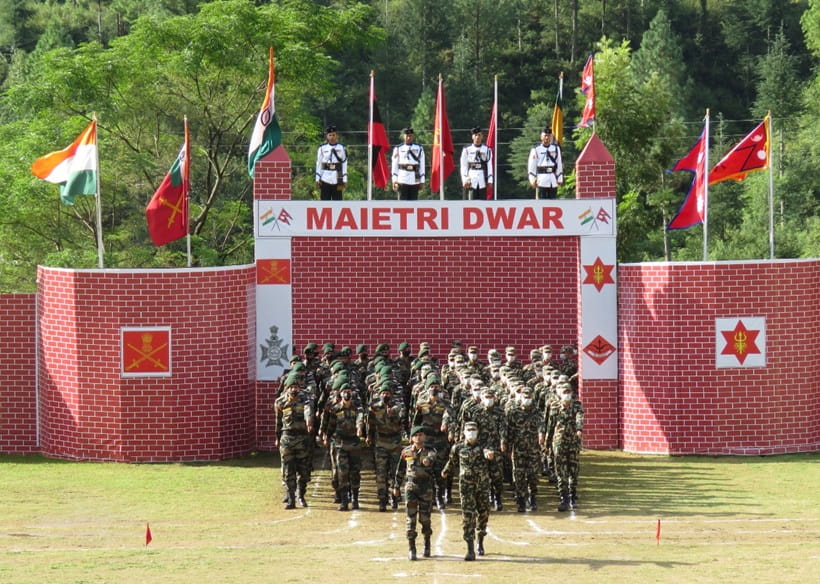
15th India-Nepal Joint Military Training Exercise ‘Surya Kiran’ at Pithoragarh, Uttarakhand, in September 2021 | MoD

15th India-Nepal Joint Military Training Exercise ‘Surya Kiran’ at Pithoragarh, Uttarakhand, in September 2021 | MoD
The fortitude of defence diplomacy has been held back with Nepal’s reluctance to permit the most decorated Nepali Gurkhas recruitment in the “Agnipath Scheme” that is going on since September 2022 with disagreements for the process is in variance with Nepal’s diplomatic posture within the new geopolitical environment. Interestingly, the 40 battalions of seven Gurkha regiments comprising 42,000 soldiers are both Nepali and Indian Gurkhas.
The Agnipath scheme launched with the intention of lessening the average age of the armed forces as well as reducing defence expenditure of India has failed to impress the political elite of Nepal as it has impacted job opportunities while curtailing an important source of Indian currency for the economy and imports that Nepal is desirous of. The scheme is about a quarter of the total strength to continue in service after four years while the others depart with a golden handshake of USD 15,000 (INR 1.7 million). It is a trilateral arrangement with bilateral agreement between India and UK with Nepal as an observer as well as Nepal’s recommendation on the employment of the Gurkhas.
Political Citations
The Agnipath Scheme was not originally part of the tripartite agreement and it does not address the question of the rights of the Gurkhas — the longevity of their military career; as well as the existing problem of unemployment within Nepal. Finally, it is possible that the weapon trained returnees could be vulnerable to non-state actors as well who could use them as a resource in the future – potentially altering the security dynamics within South Asia.
The Gurkhas’ presence in various military forces, has played a role in influencing and maintaining geo-political stability beyond the Indian subcontinent and global reputation. The global recognition for exceptional military abilities and professionalism is highly regarded globally.
The absence of Nepali Gurkhas within the Indian armed forces could potentially alter the bilateral relationship, balance of power and have serious implications for the region. Additionally, the international community’s perception of Nepal and India’s bilateral ties might be affected, potentially hampering diplomatic cooperation on various issues impacting the scope of national and International Relations.
Historical Precedents
The longstanding recruitment ties have fostered close bilateral relations between Nepal and India. Both countries share an enduring historical and cultural connection. During the ratification of the Tripartite Agreement, Nepal wanted to ensure that there would be no discrimination between Gurkhas and the host army and that Gurkha troops would not to be treated as mercenaries.
The Tripartite Treaty followed by the 1950 Treaty of Peace and Friendship underpinned Nepalese nationals the right to work in India and for equal national treatment but short of any provisions of engagement or benefits.
The “Maoists 40 points demand” put forward on February 4, 1996, revealed the closure of the Gurkha recruitment centres and the introduction of a work permit system for foreign workers. Bhim Rawal, former Defence Minister in the past KP Oli government called for the termination of the Tripartite Treaty in the parliament as the Agnipath Scheme had violated the essence assembling it the bedrock substratum for politics. But for many, it has provided an opportunity of global repute and a military career.
Limited Political Consensus
Defence Minister Rajnath Singh said that the Scheme is a ‘transformative reform to enhance the combat potential of Armed Forces with a younger profile and technologically-adept soldiers.
Although the government of Baburam Bhattarai in 2012 attempted to put an end to further enlistment in the Indian Army, it was viewed as a lucrative employment opportunity by the Nepalese.
However, Nepali Foreign Minister NP Saud obliquely said that the recruitment of Gurkhas would be postponed “We have a policy that if there is any change made to a tripartite treaty, then it should be implemented through a political consensus.”
Pradeep Kumar Gyawali, a senior leader of the main opposition Communist Party of Nepal (UML) and former Foreign Minister added, “We are not going to accept the new plan. If India is ready to revert back to the older Gurkha recruitment process, then it can be resumed.”
There is limited political consensus for the resumption of modified recruitment as most of the political parties oppose the unilateral decision in the recruitment scheme that the government of India has implemented.
Nepalese Opposition to Enlistment
The June 2022 approved Scheme trails Nepal’s official proposal with Britain on 12 February 2020 for a review of the 1947 Tripartite Agreement on Gurkha soldier’s incentives and conveniences that is old and does not serve the present needs in the changed context. The proposal raised inconsistency when Pradeep Gyawali then Foreign Minister said that the British Government responded “positively” while KP Oli then Prime Minister revealed “We want to review it and make it a bilateral one, in this spirit, I proposed a review but the British side did not accept it”. The House Committee in March 2019 has also directed the Government of Nepal to take up the Tripartite Agreement and the issue of Gurkha veterans with the British government on a priority basis.
Financial Remuneration
Remittance flows remain a major source of external income with 23 percent of the GDP of Nepal in 2022 being accounted for by remittance with USD 9 billion, an increase of USD 1 billion from 2021. At the same time more than four hundred thousand youth travel abroad for work opportunity. Based on Agreement and Treaties, Brunei, India, Singapore and the UK have been destinations for Gurkhas. But recently, Nepali youth have been part of Russian forces fighting in Ukraine as well as other countries. Despite the fact that it is about an individual’s freedom of choice enshrined in the Declaration of Human Rights as well as the lack of domestic opportunities for employment, it goes against the essence of Nepal’s policies.
India: Nepal’s Preferred Choice
India is the main destination of choice for Nepalese due to existing bilateral arrangements, open borders, close proximity, similar culture and contemporary reality. The Indian Embassy in Kathmandu states that 8 million Nepalese citizens live and work in India and 600,000 Indians live in Nepal, which is different from other estimates of 1 to 3 million Nepalese working in India. The difficulty in gauging the actual numbers is due to the high mobility of Nepali workers; pervasiveness of cross-border marriages; the Indian population with ancestries in Nepal and the Nepalese obtaining domicile status in India.
According to the World Bank’s Bilateral Remittance Matrix of 2017, the value of remittance from India to Nepal by Nepali workers was USD 1 billion, while remittance from Nepal to India in the same year was USD 3 billion.
The salaries of the serving and the pensions of about 1,22,000 Indian Gurkha veterans living in Nepal and the remittances sent by them have provided Nepal with an economic cushion. Their contribution and other benefits accrued amounted to around USD 620 million (INR 45 Crores), equivalent to 3.7 percent of Nepal’s GDP in 2015 and more than the military budget of Nepal of USD 450 million (around Rs 60 billion), amounting to 3.5 percent of the total government expenditure.
The likelihood of Indian Gurkhas replacing the Nepali Gurkhas could be a temporary choice for the Indian Armed forces due to traditional linkages and bonds dating from the 18th century. Such a move will also have long standing strategic implications within an ever altering geopolitical landscape.
Conclusion
Shifting geostrategic dynamics, global rivalry, rise in global migration and conscription through different methods and routes are a matter of concern.
Therefore, engaging vulnerable youth, and focus on traditional features and rich historical relationships is important for political-security, political-economy and political-cultural growth. Additionally, recognising the financial implications and cultural connections attached to the Gurkhas’ service is vital to ensure the well-being of individuals, their communities and contributes to upholding regional stability by bolstering Nepal’s defence capabilities for national security.
Recognising the Gurkhas as an integral part of the Indian Army reinforces the national interests of both the countries as its absence would weaken the ‘diplomatic bridge’ between Nepal and India.
(Exclusive to NatStrat)